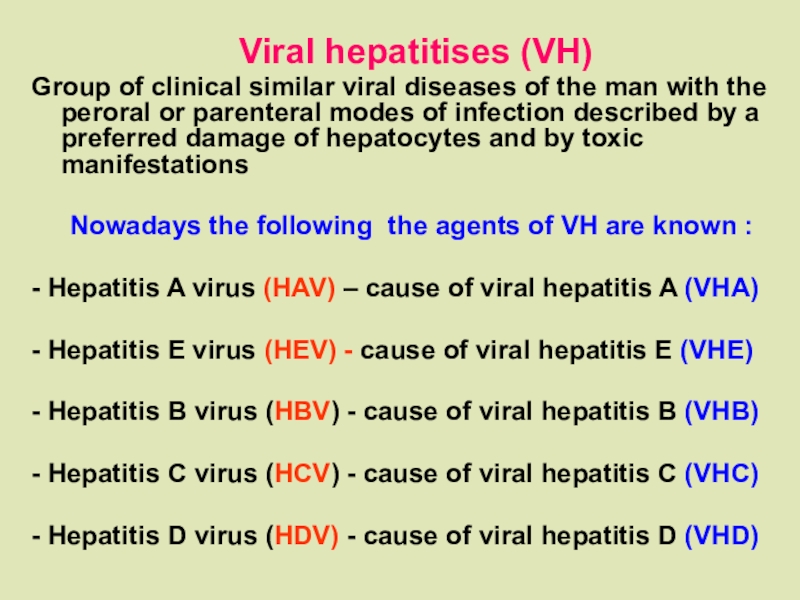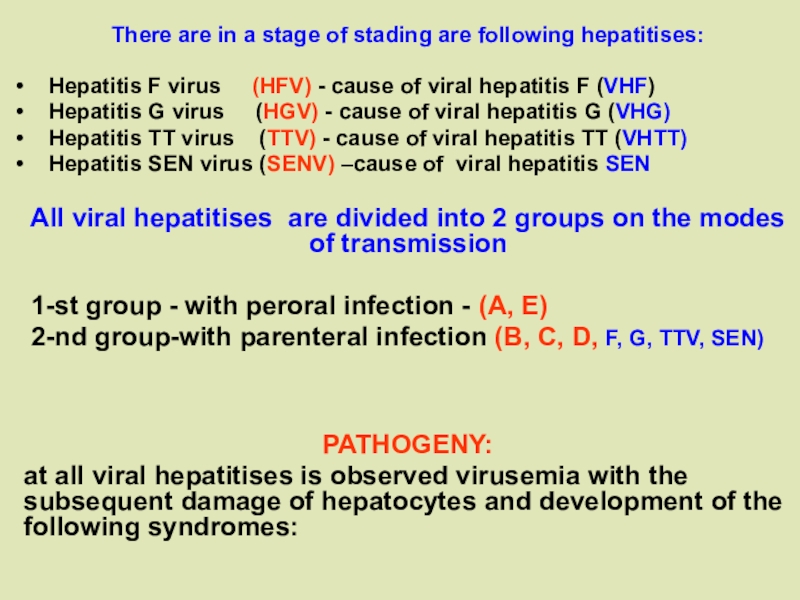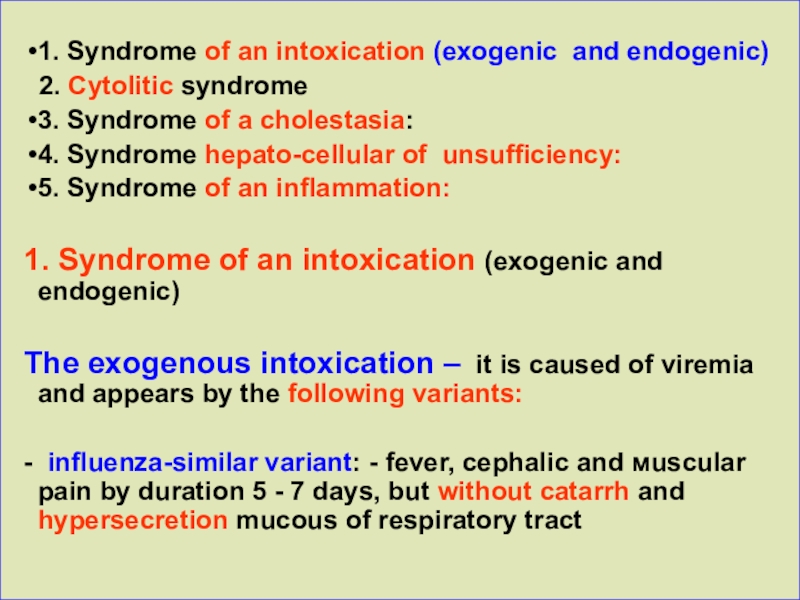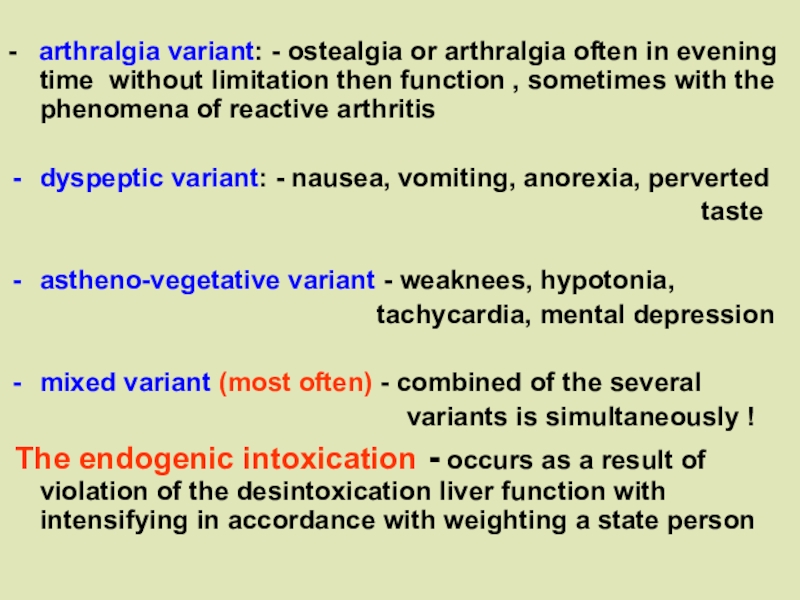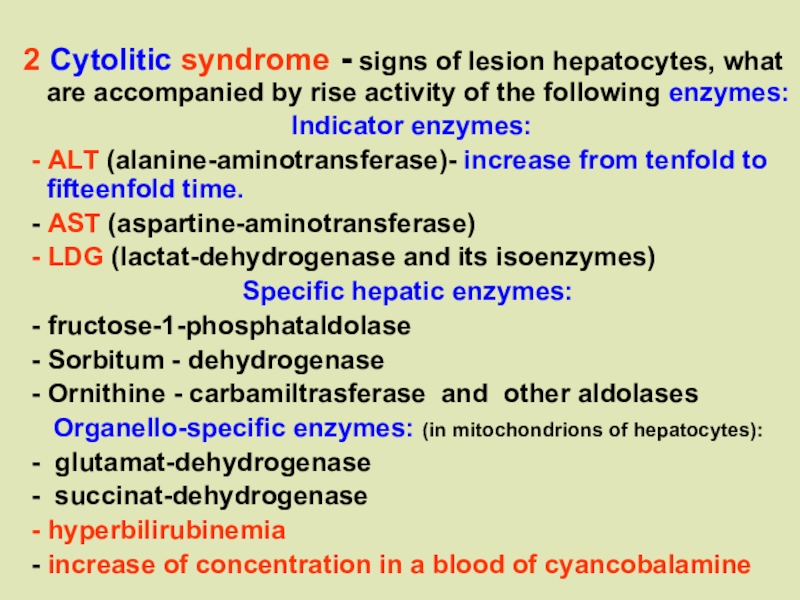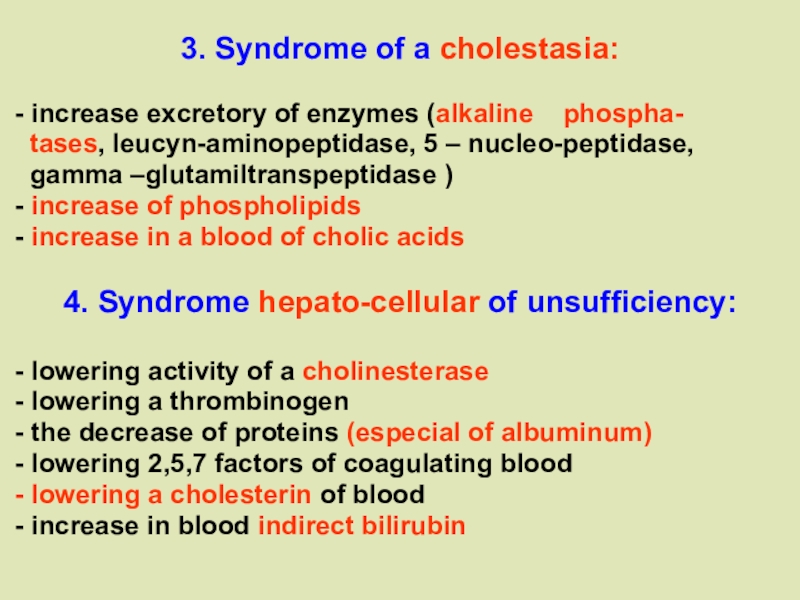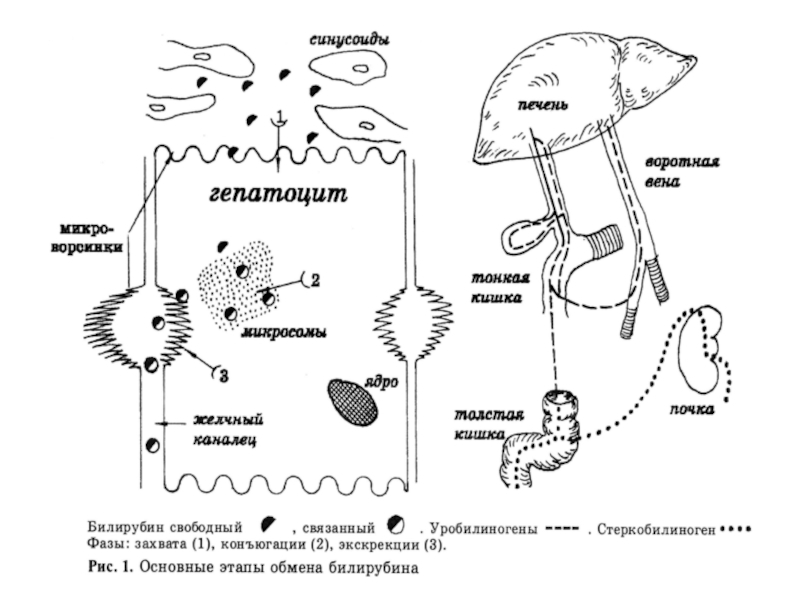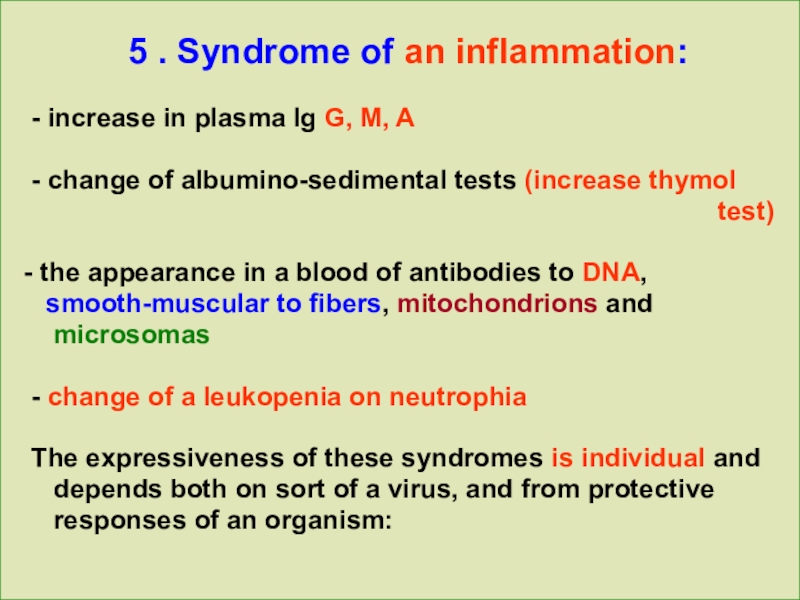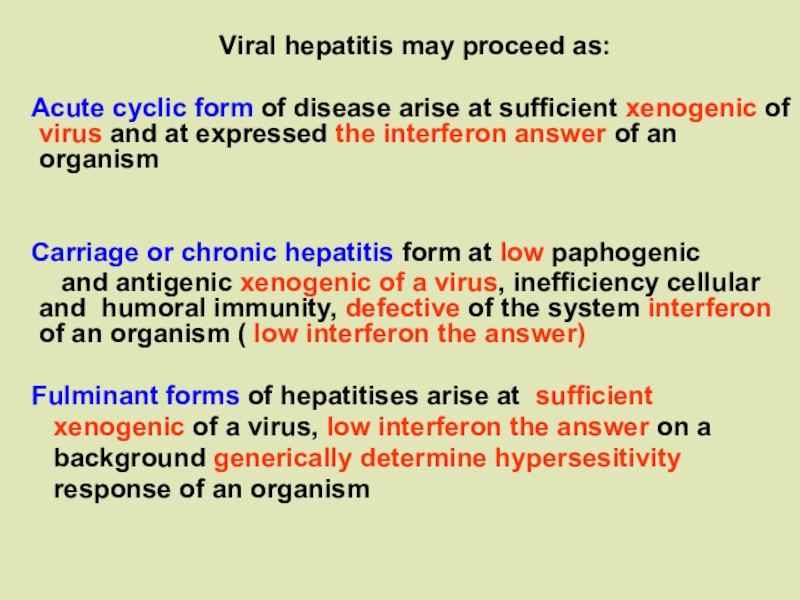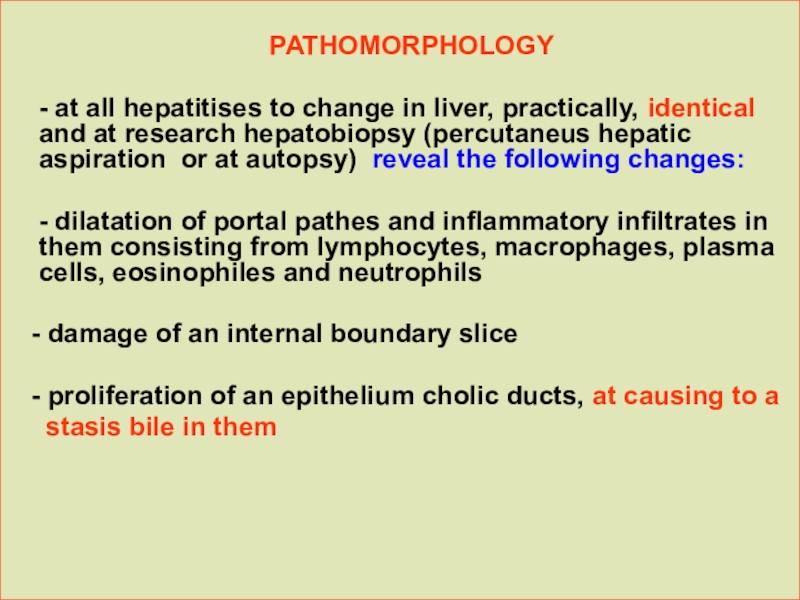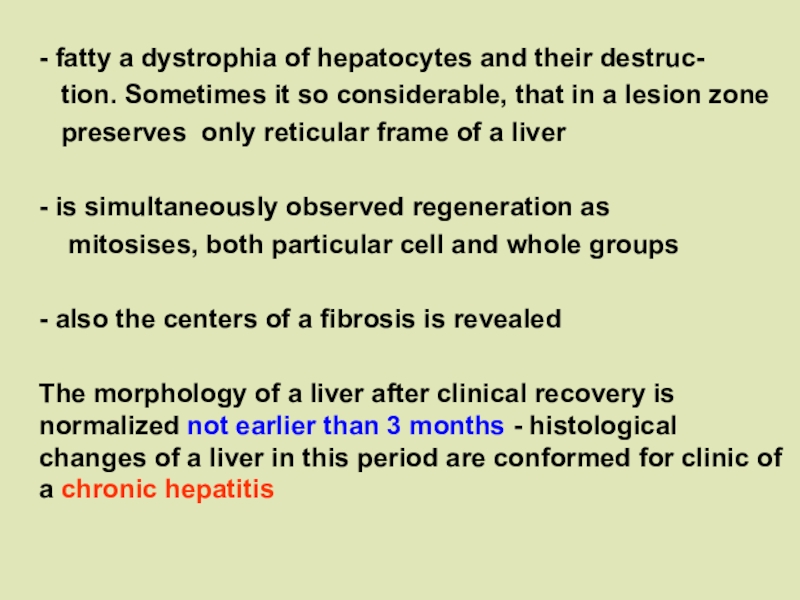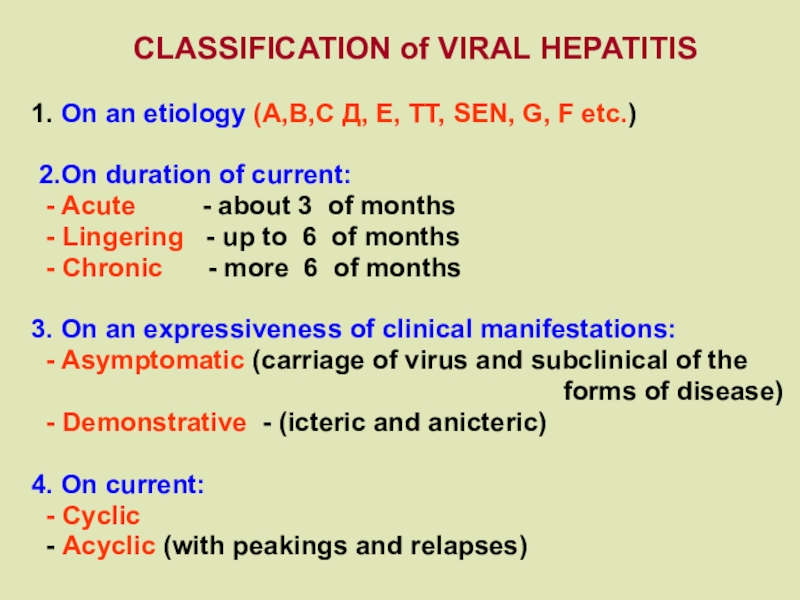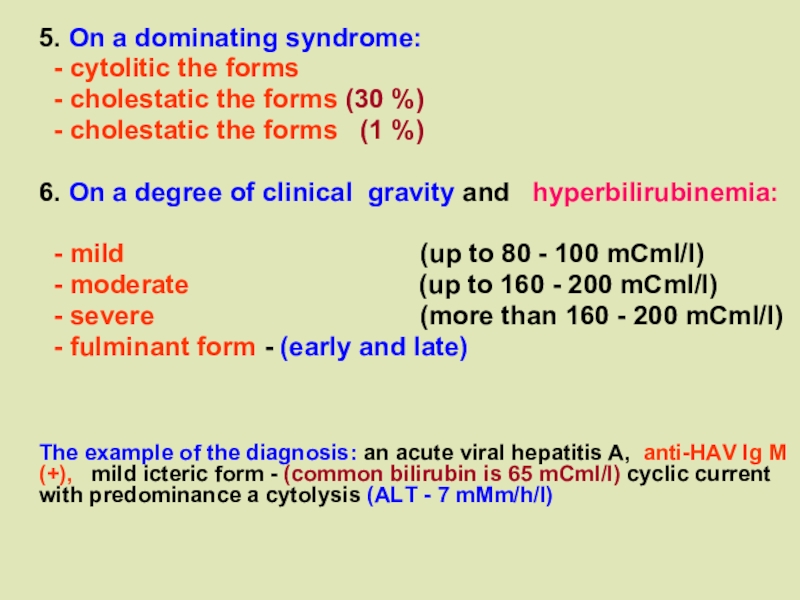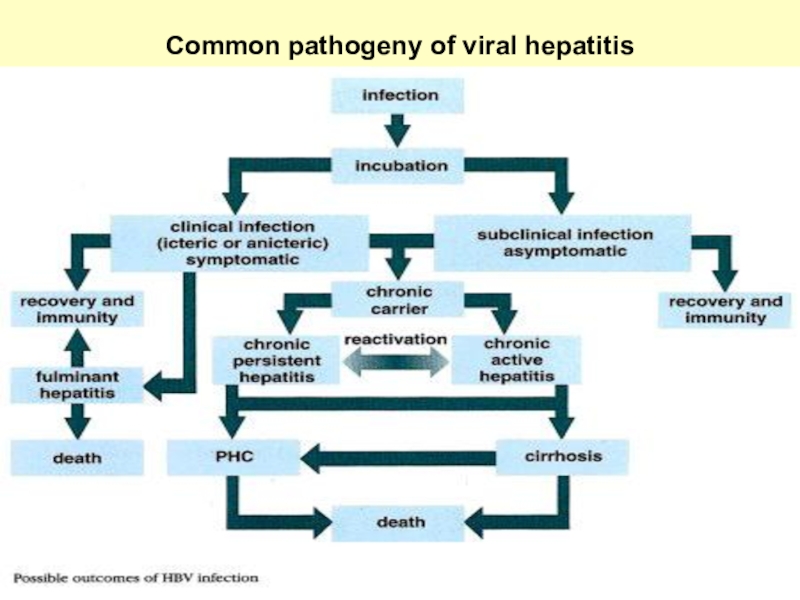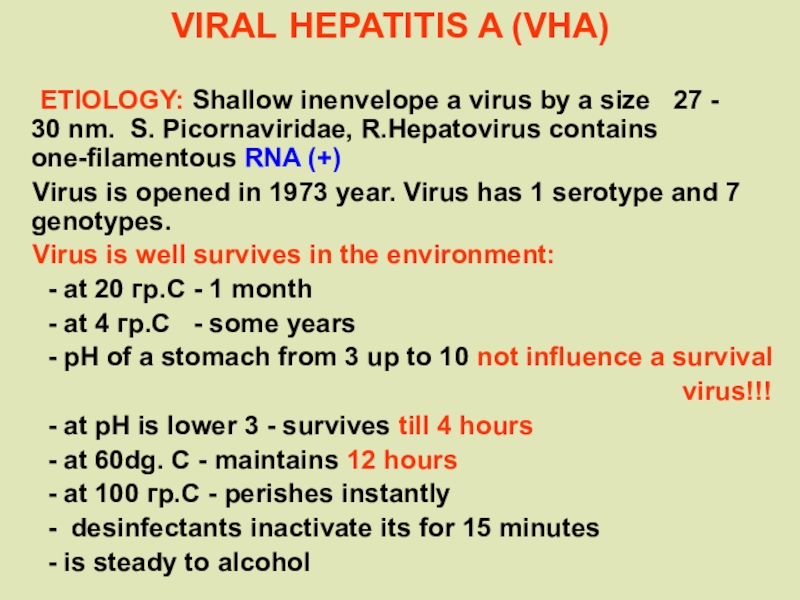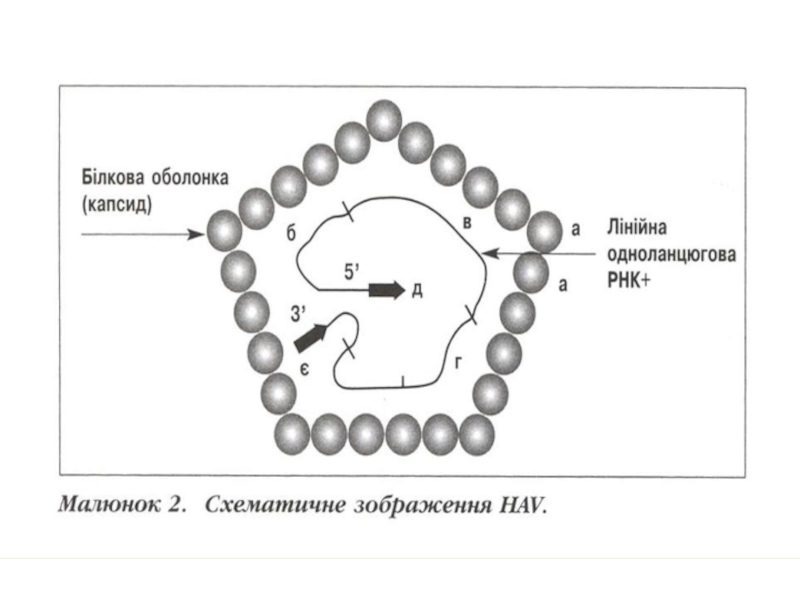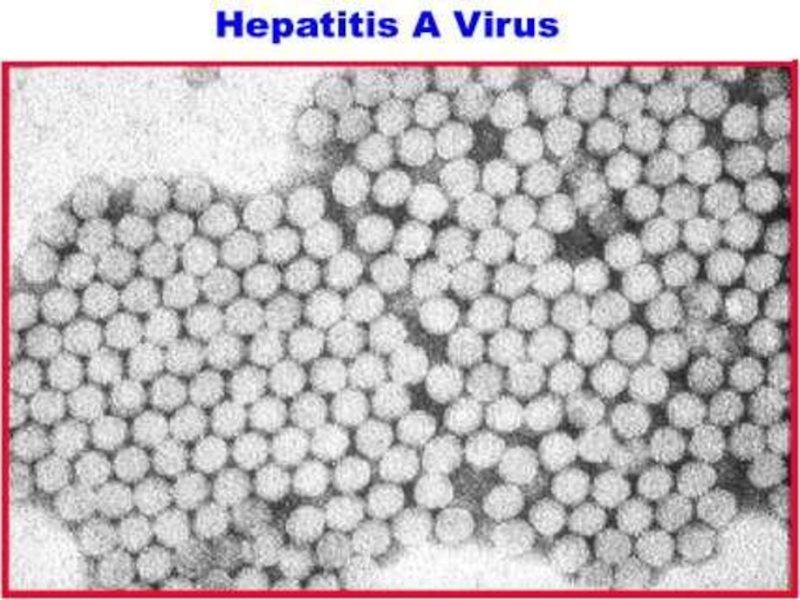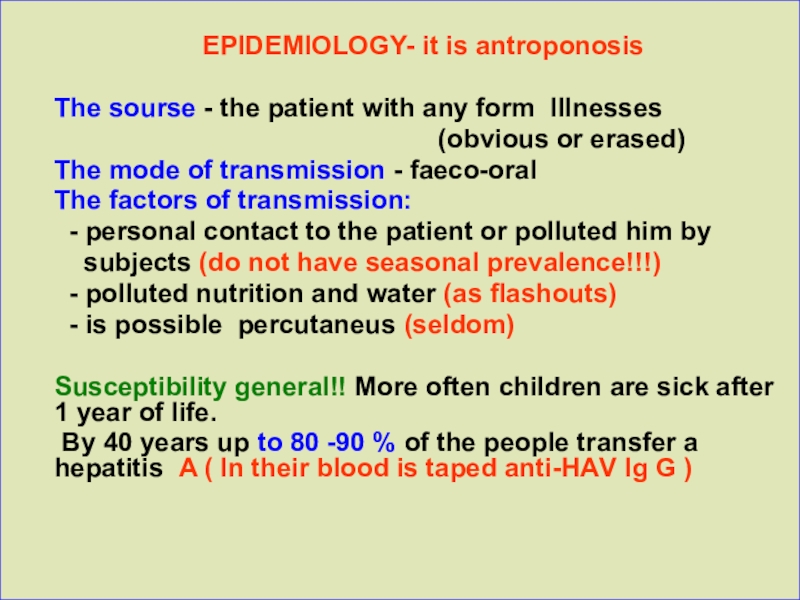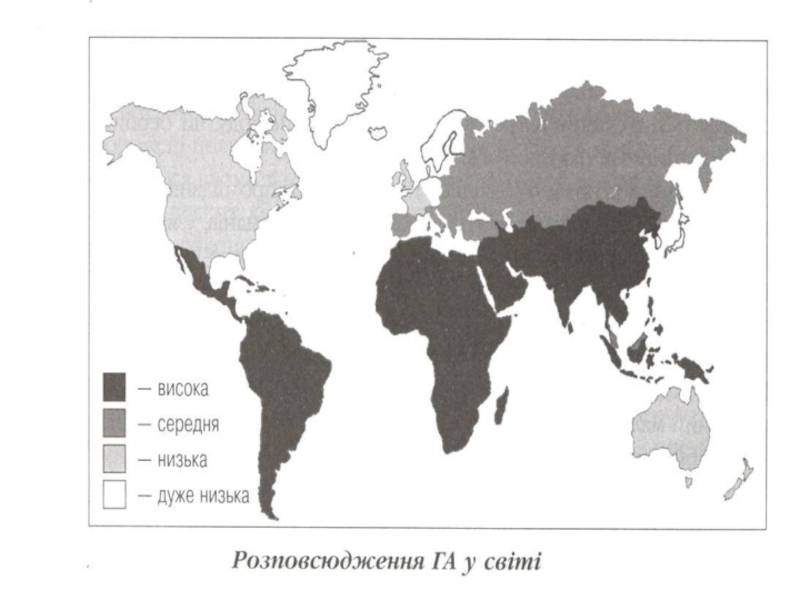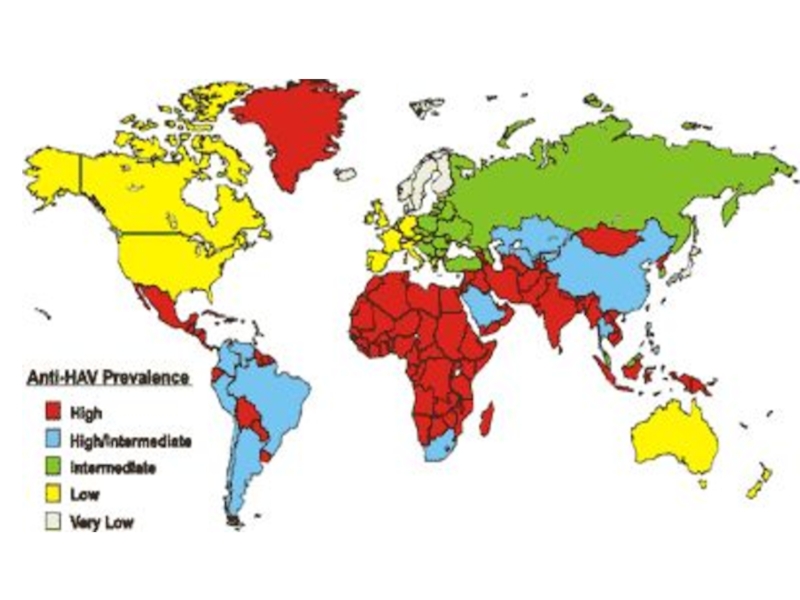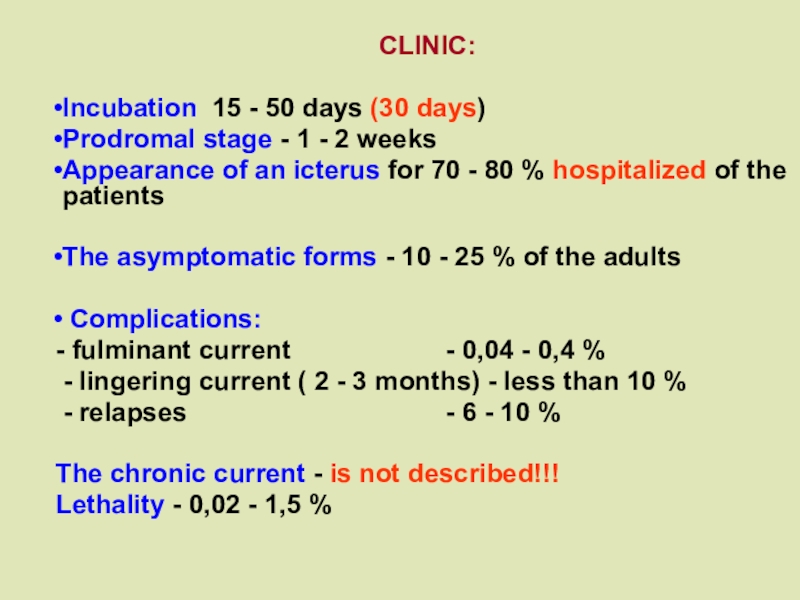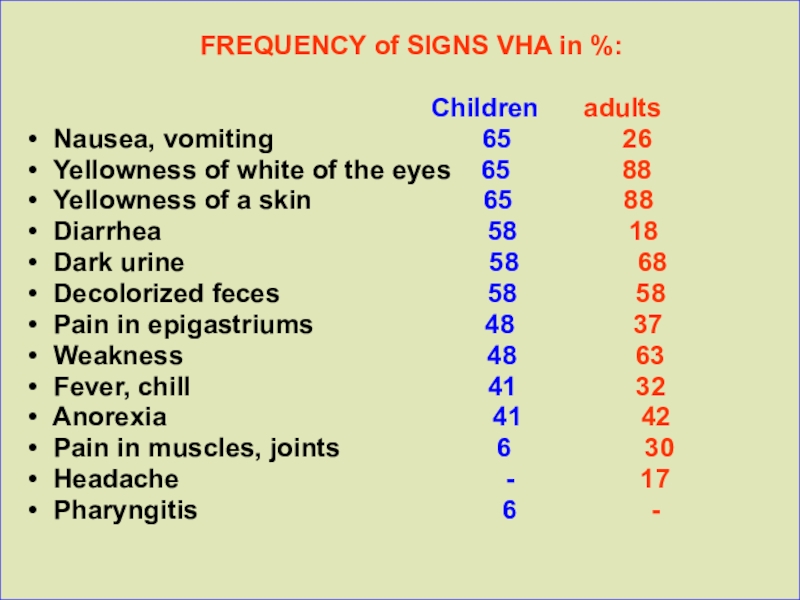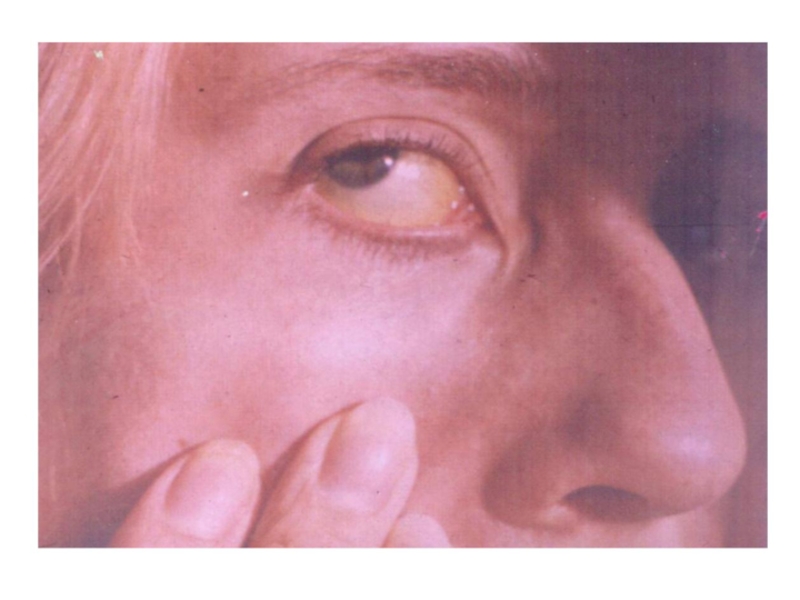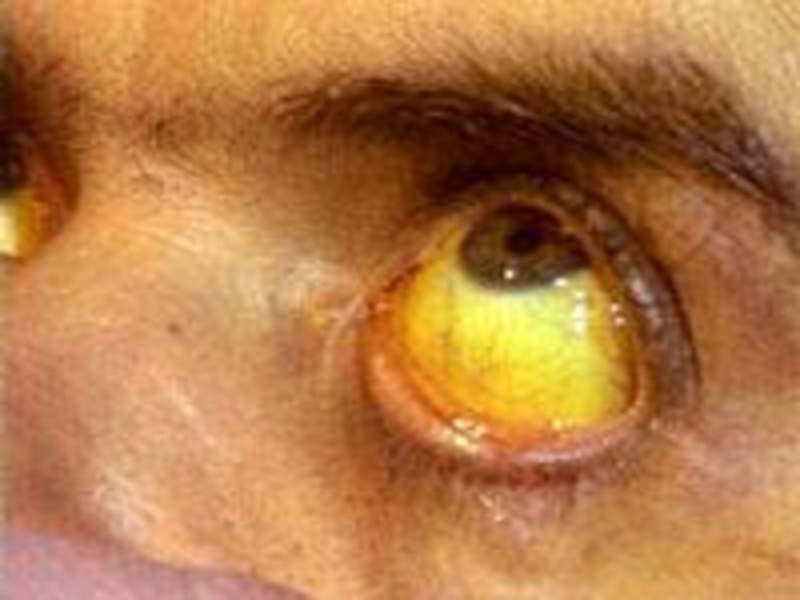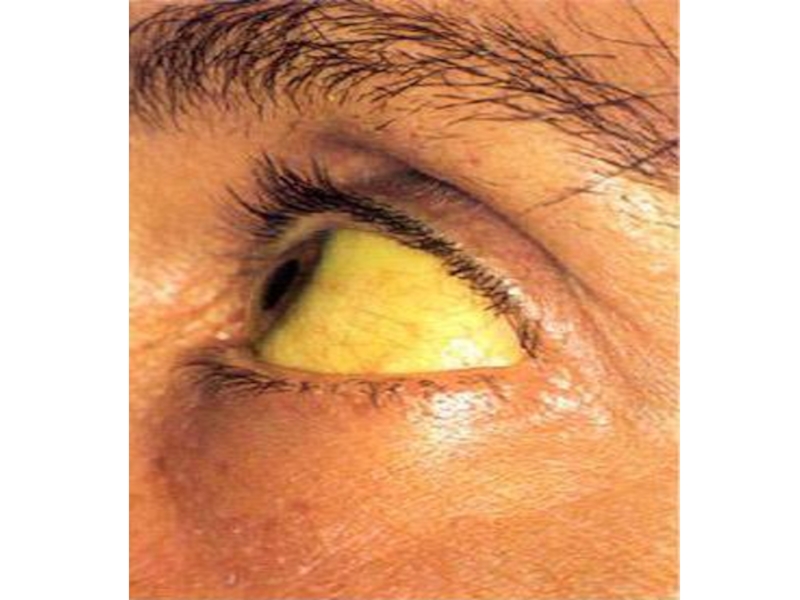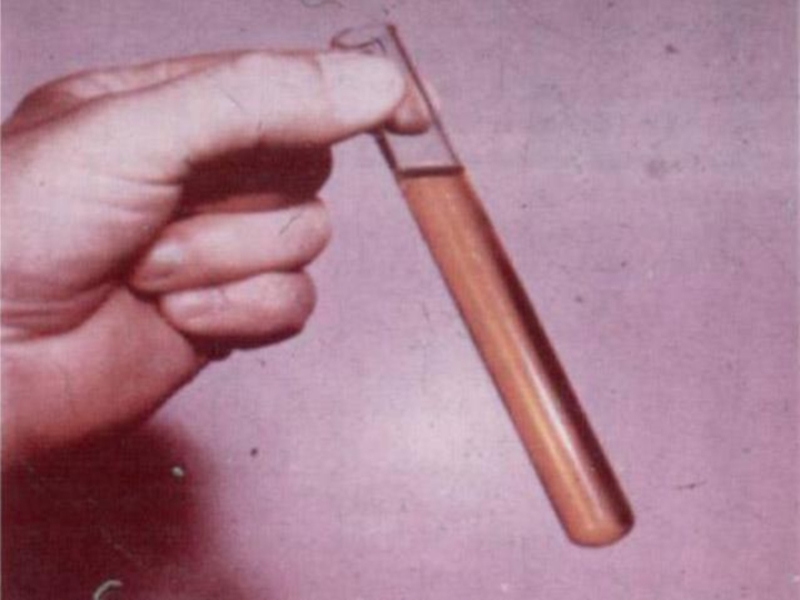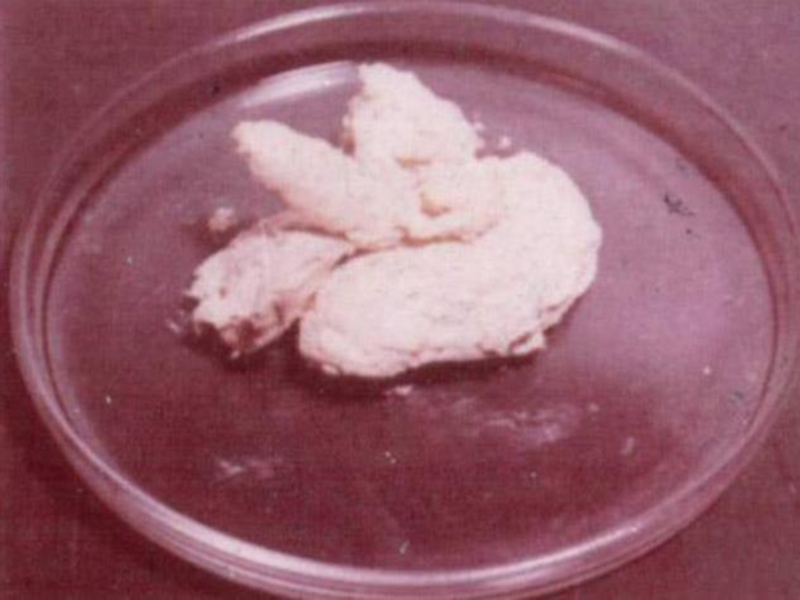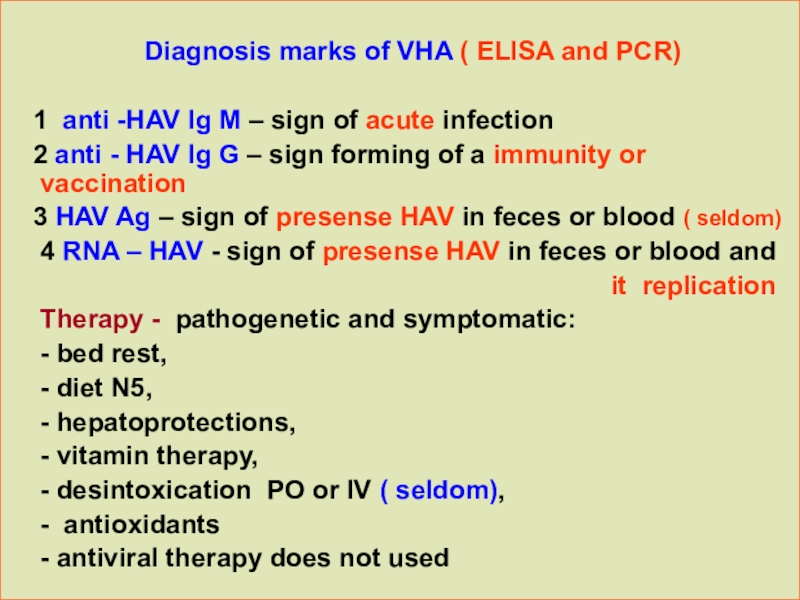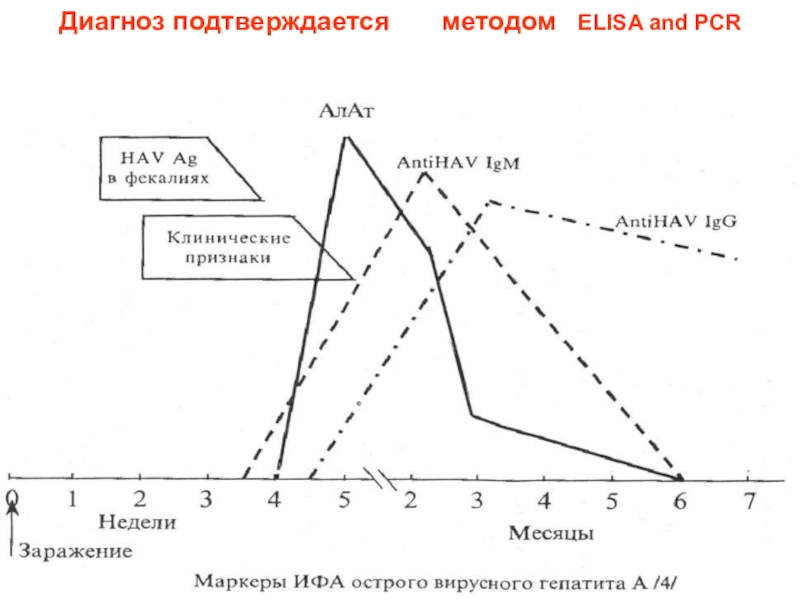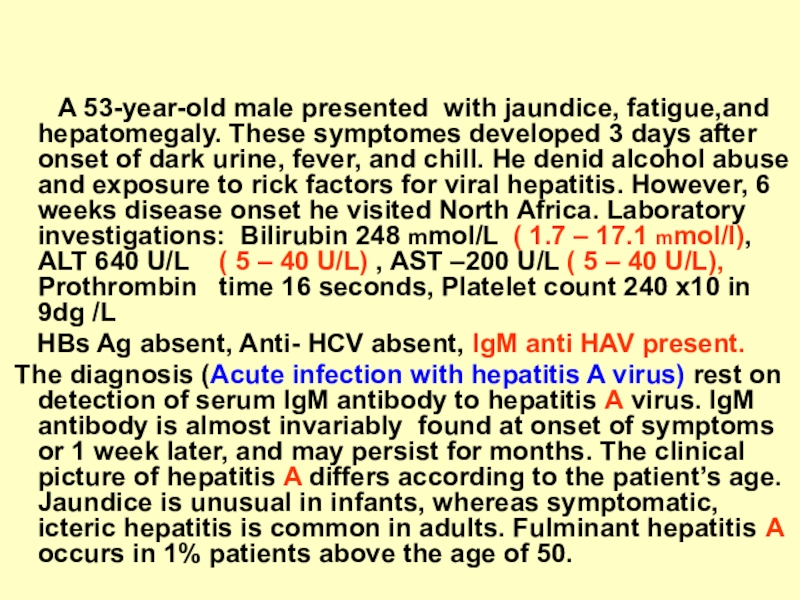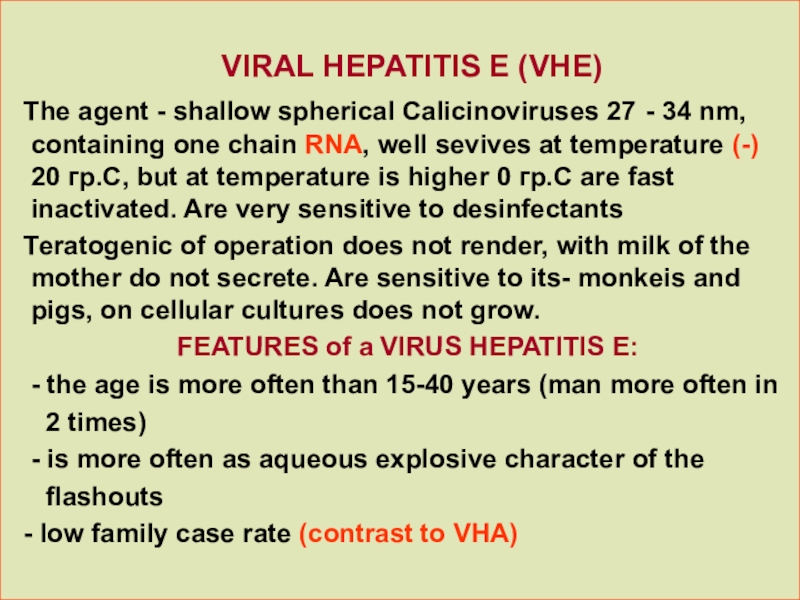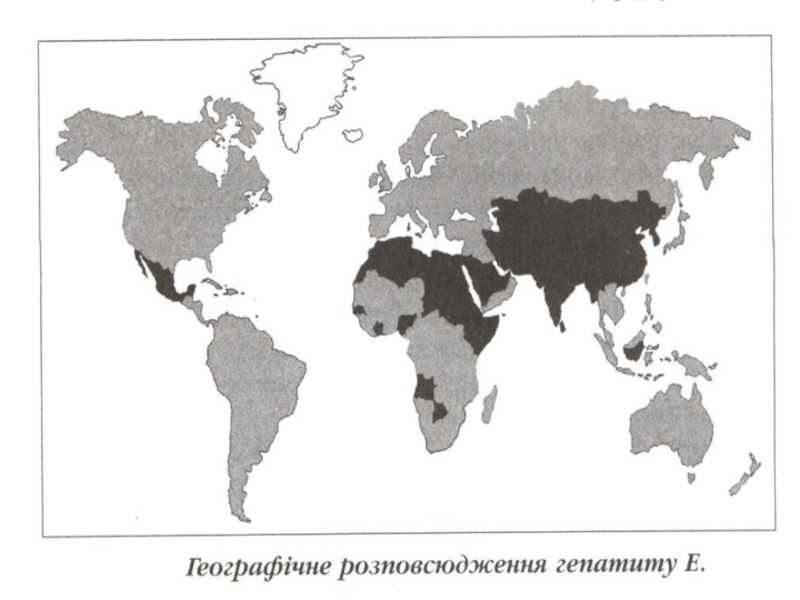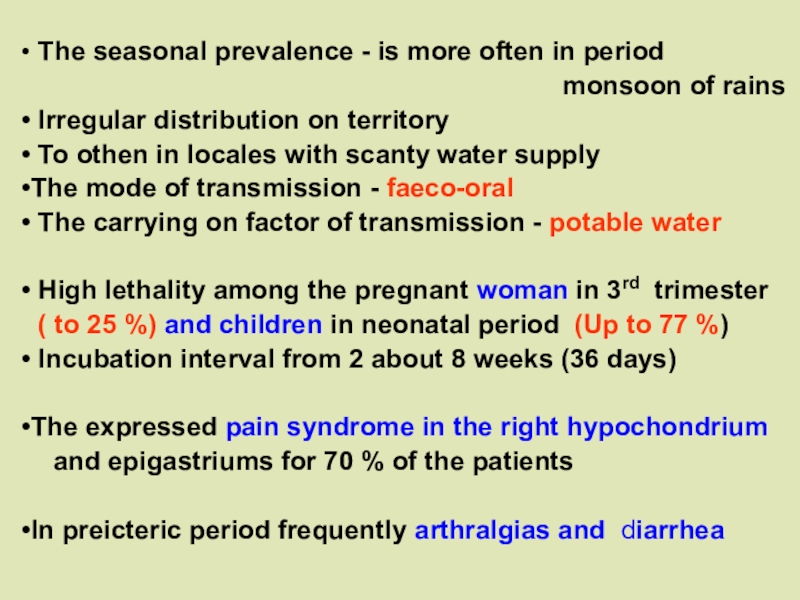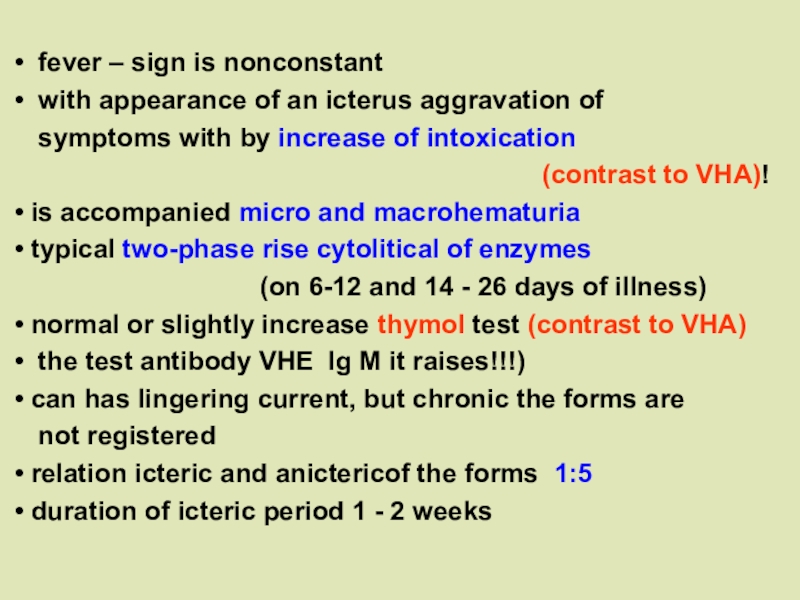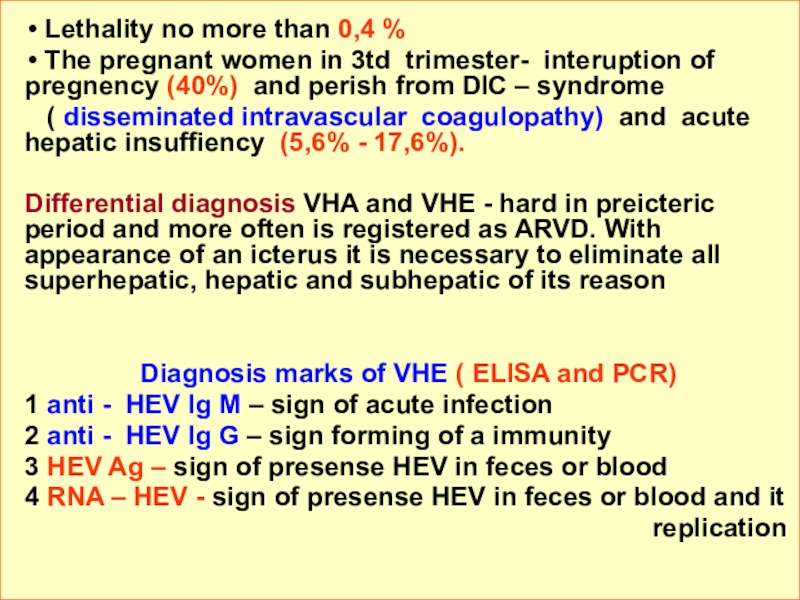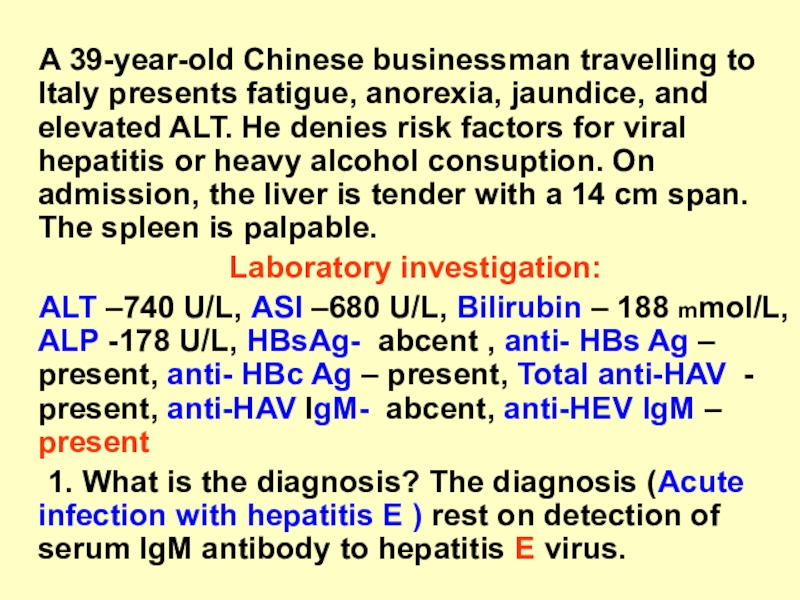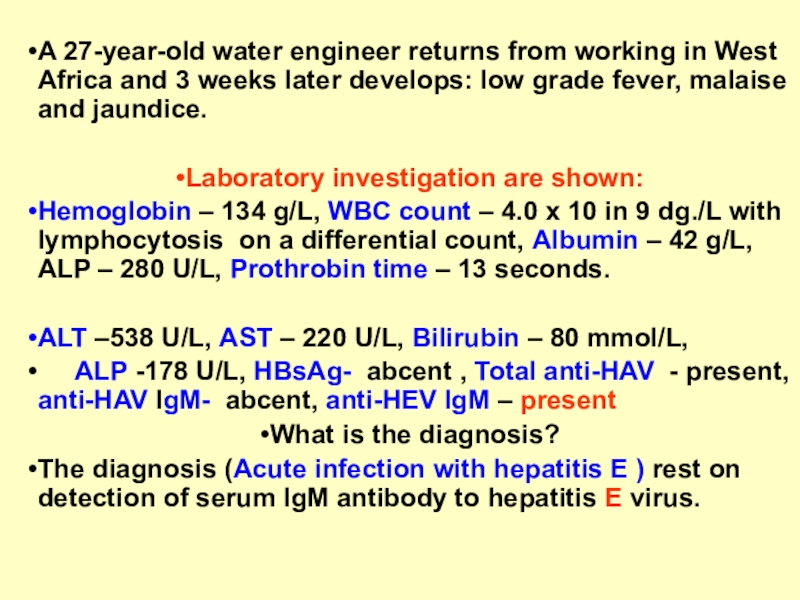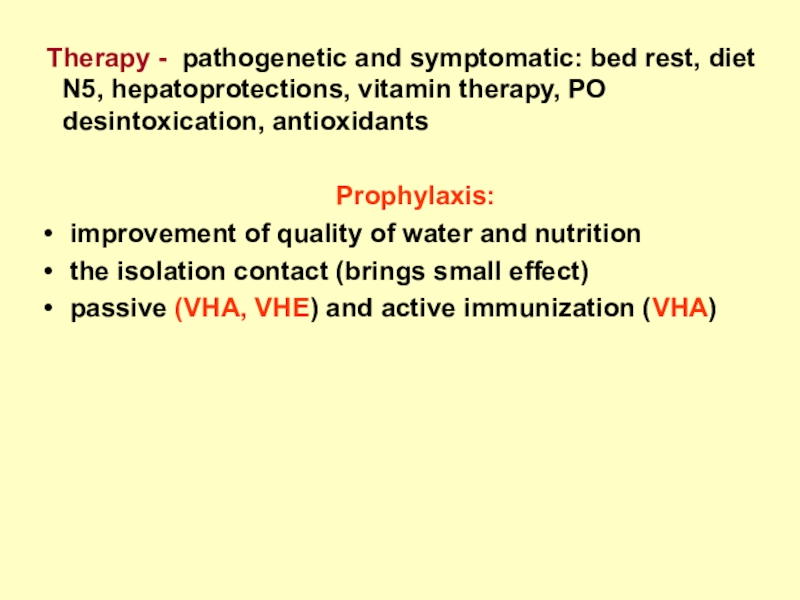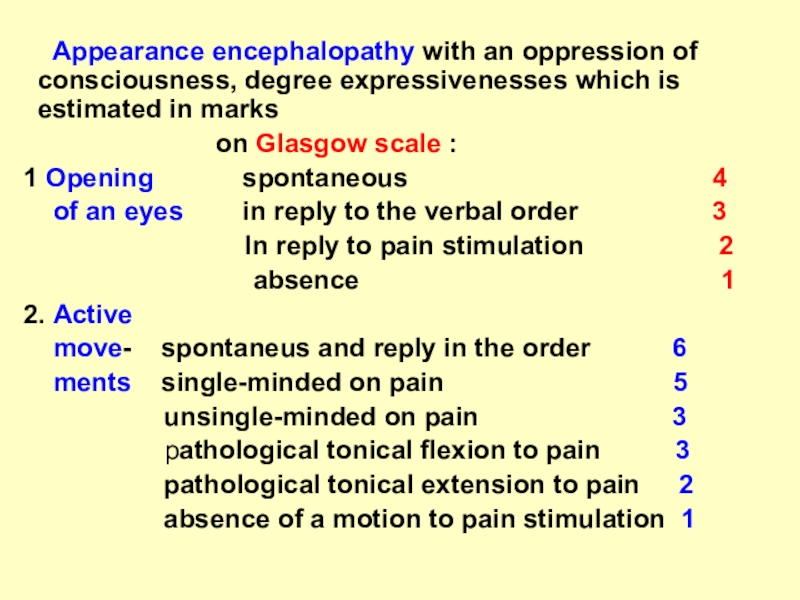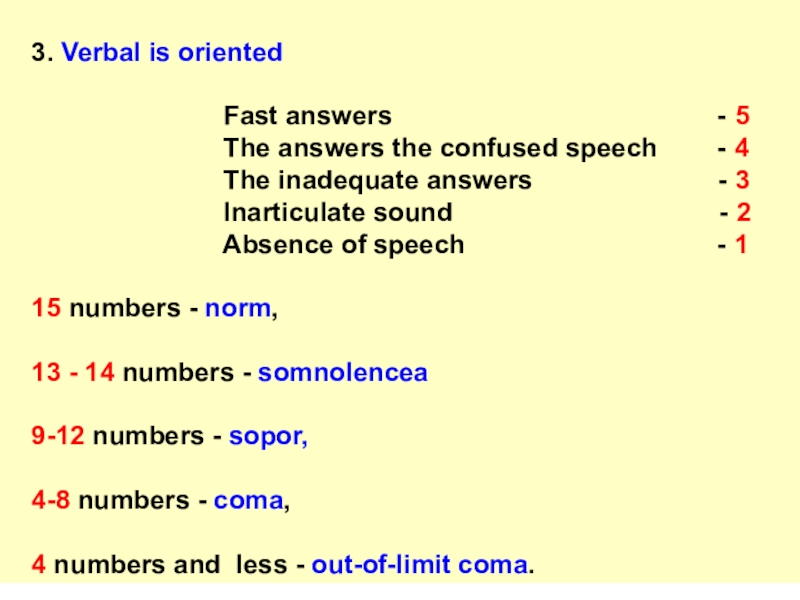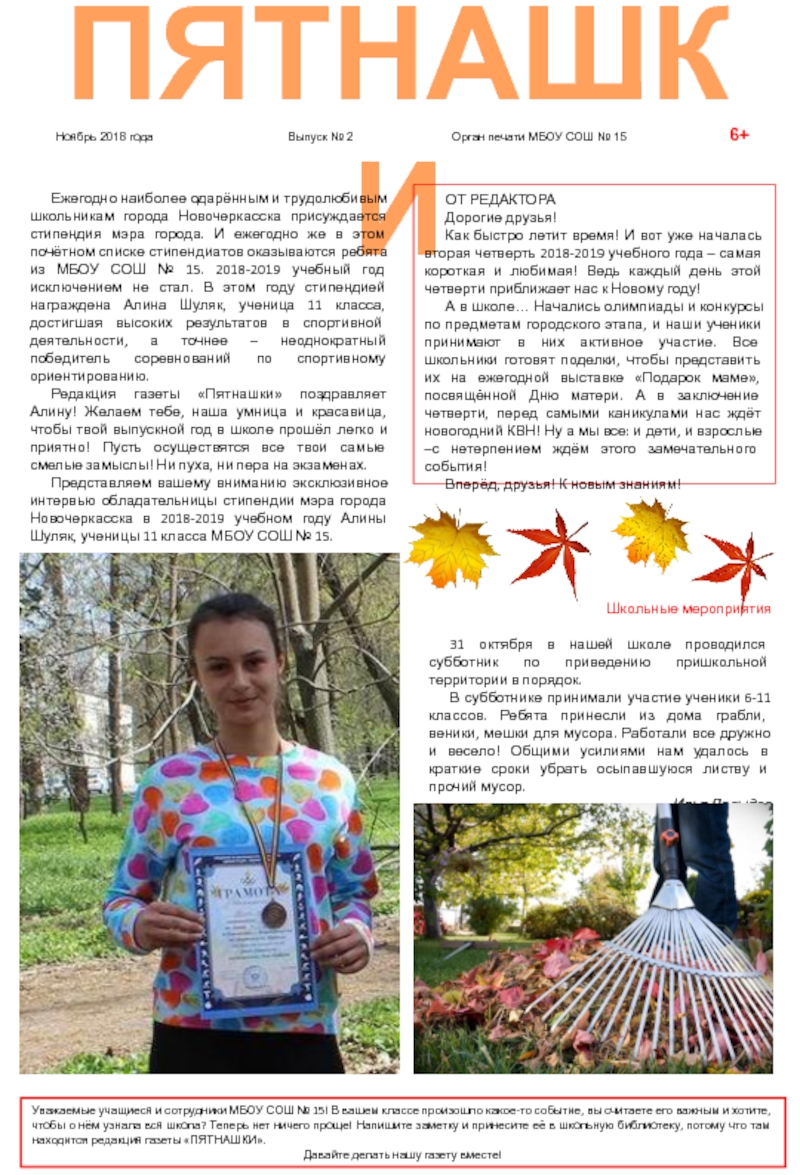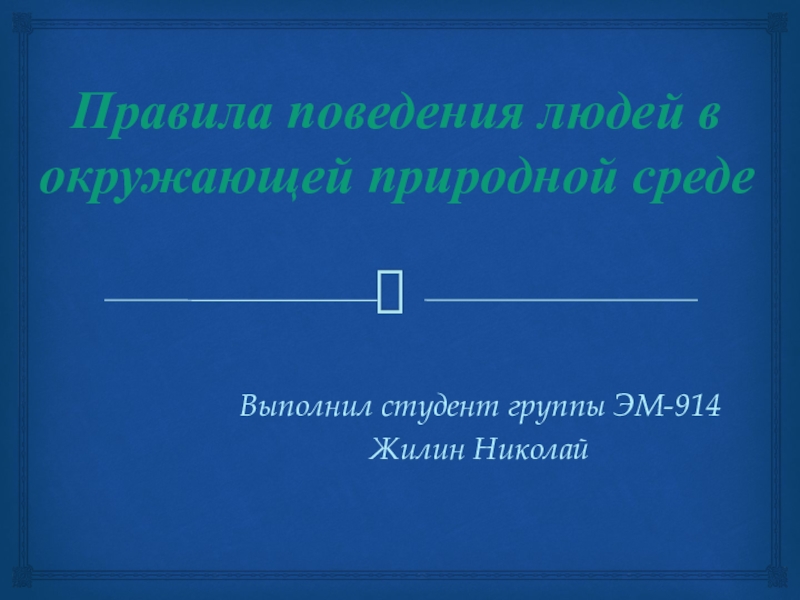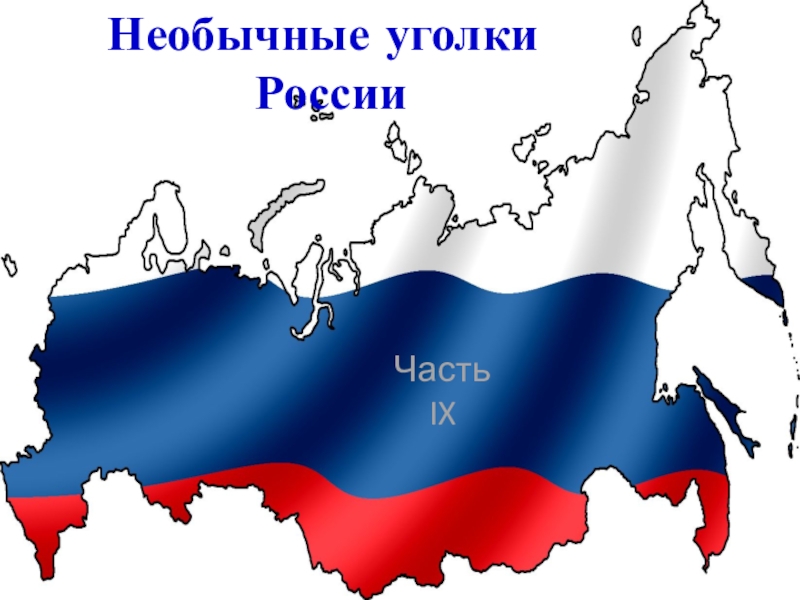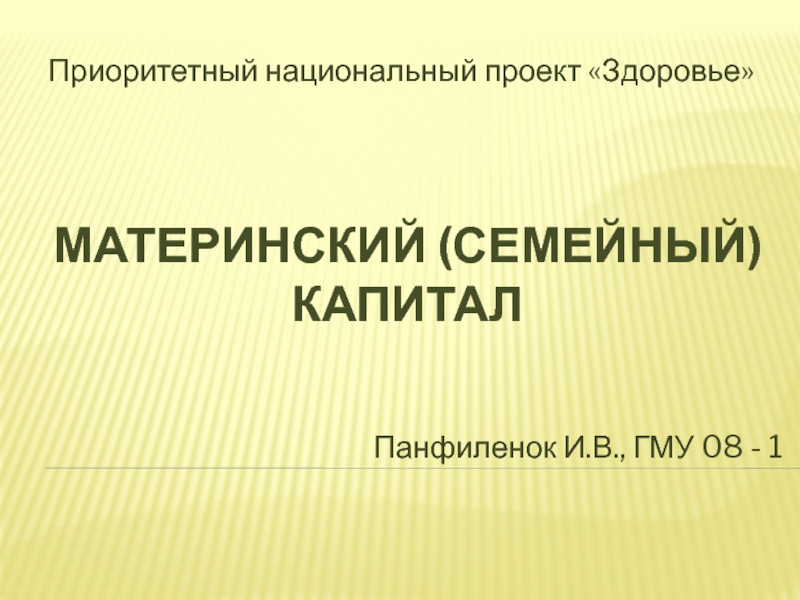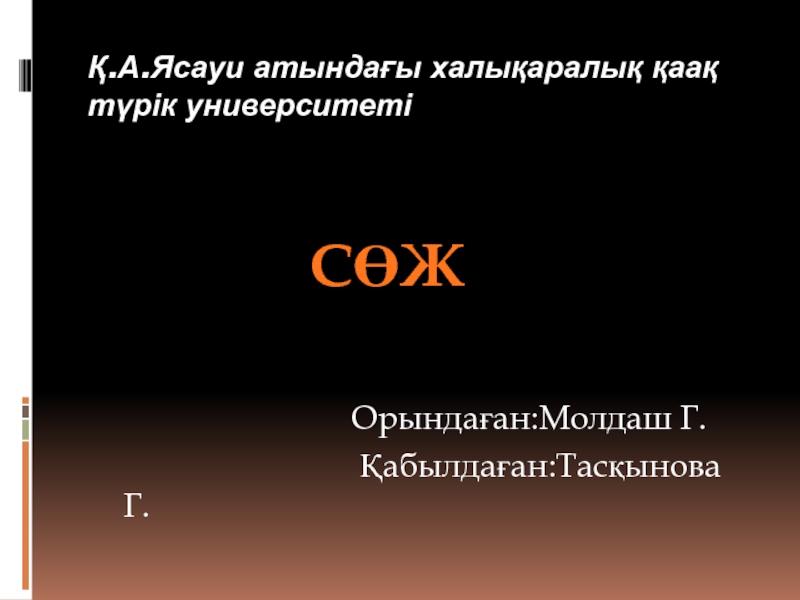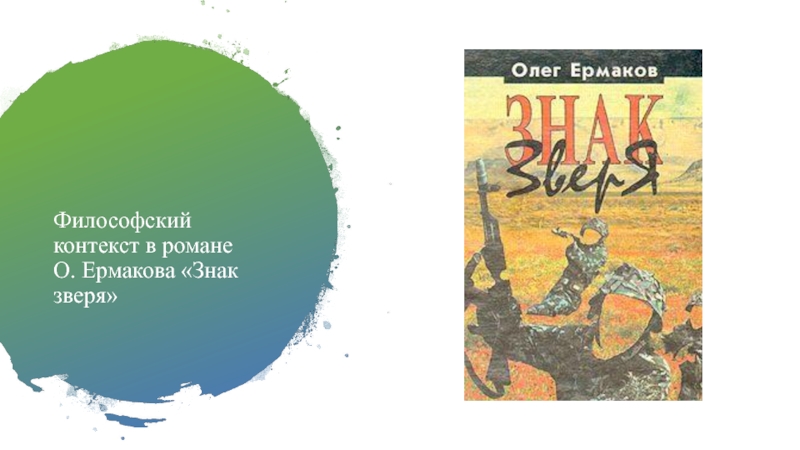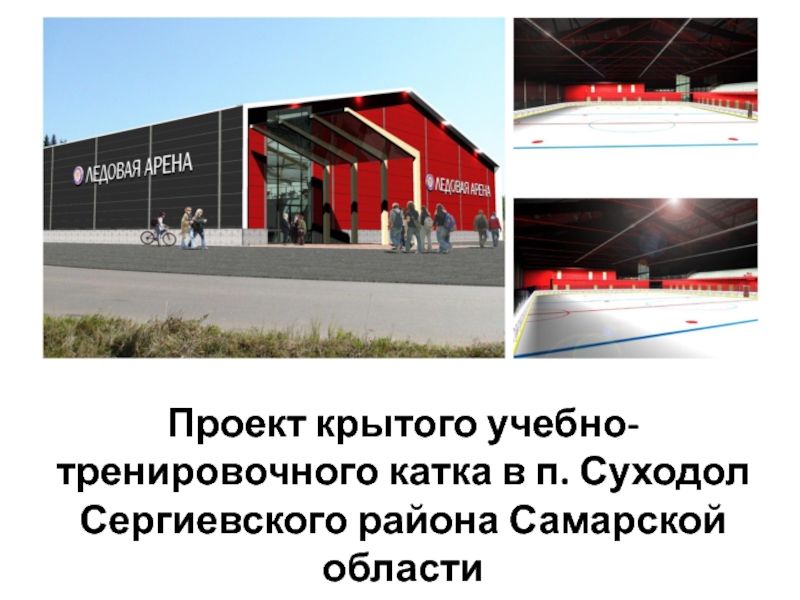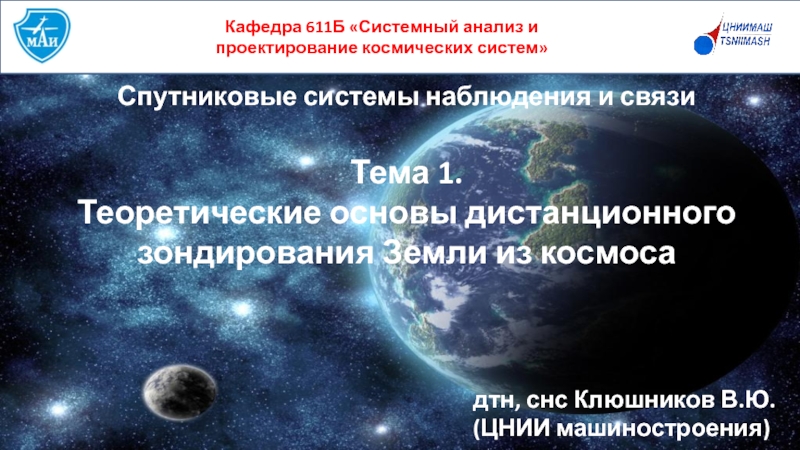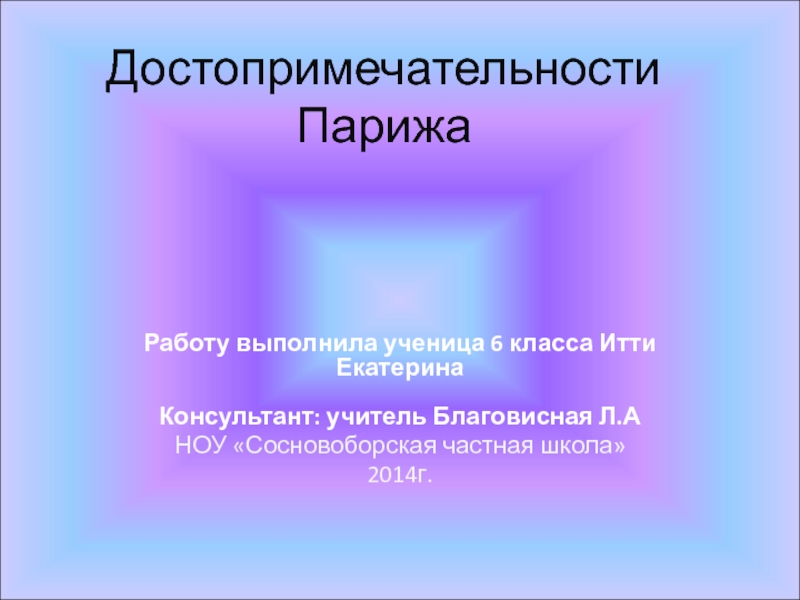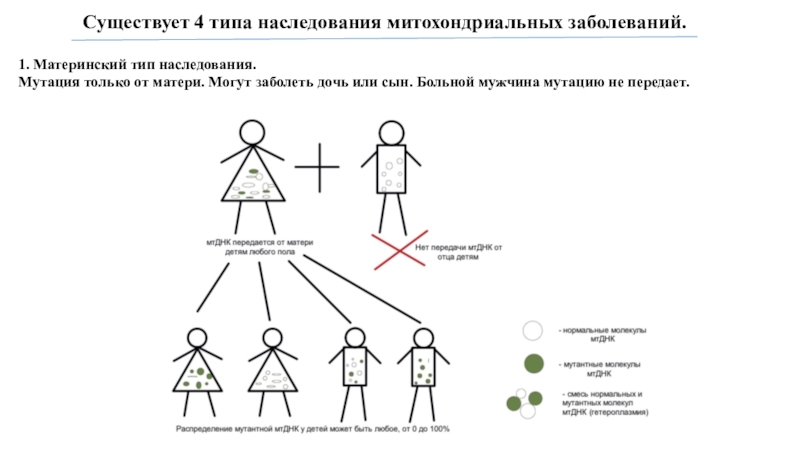Слайд 1
Viral hepatitises (VH)
Group of clinical similar viral diseases of
the man with the peroral or parenteral modes of infection
described by a preferred damage of hepatocytes and by toxic manifestations
Nowadays the following the agents of VH are known :
- Hepatitis A virus (HAV) – cause of viral hepatitis A (VHA)
- Hepatitis E virus (HEV) - cause of viral hepatitis E (VHE)
- Hepatitis B virus (HBV) - cause of viral hepatitis B (VHB)
- Hepatitis C virus (HCV) - cause of viral hepatitis C (VHC)
- Hepatitis D virus (HDV) - cause of viral hepatitis D (VHD)
Слайд 2
There are in a stage of stading are following hepatitises:
Hepatitis F virus (HFV) - cause
of viral hepatitis F (VHF)
Hepatitis G virus (HGV) - cause of viral hepatitis G (VHG)
Hepatitis TT virus (TTV) - cause of viral hepatitis TT (VHTT)
Hepatitis SEN virus (SENV) –cause of viral hepatitis SEN
All viral hepatitises are divided into 2 groups on the modes of transmission
1-st group - with peroral infection - (A, E)
2-nd group-with parenteral infection (B, C, D, F, G, TTV, SEN)
PATHOGENY:
at all viral hepatitises is observed virusemia with the subsequent damage of hepatocytes and development of the following syndromes:
Слайд 3
1. Syndrome of an intoxication (exogenic and endogenic)
2. Cytolitic syndrome
3. Syndrome of a cholestasia:
4. Syndrome hepato-cellular
of unsufficiency:
5. Syndrome of an inflammation:
1. Syndrome of an intoxication (exogenic and endogenic)
The exogenous intoxication – it is caused of viremia and appears by the following variants:
- influenza-similar variant: - fever, cephalic and мuscular pain by duration 5 - 7 days, but without catarrh and hypersecretion mucous of respiratory tract
Слайд 4
- arthralgia variant: - ostealgia or arthralgia often in
evening time without limitation then function , sometimes with the
phenomena of reactive arthritis
dyspeptic variant: - nausea, vomiting, anorexia, perverted
taste
astheno-vegetative variant - weaknees, hypotonia,
tachycardia, mental depression
mixed variant (most often) - combined of the several
variants is simultaneously !
The endogenic intoxication - occurs as a result of violation of the desintoxication liver function with intensifying in accordance with weighting a state person
Слайд 5
2 Cytolitic syndrome - signs of lesion hepatocytes, what are
accompanied by rise activity of the following enzymes:
Indicator enzymes:
- АLТ (аlanine-aminotransferase)- increase from tenfold to fifteenfold time.
- АSТ (aspartine-aminotransferase)
- LDG (lactat-dehydrogenase and its isoenzymes)
Specific hepatic enzymes:
- fructose-1-phosphataldolase
- Sorbitum - dehydrogenase
- Ornithine - carbamiltrasferase and other aldolases
Оrganello-specific enzymes: (in mitochondrions of hepatocytes):
- glutamat-dehydrogenase
- succinat-dehydrogenase
- hyperbilirubinemia
- increase of concentration in a blood of cyancobalamine
Слайд 6
3. Syndrome of a cholestasia:
- increase excretory of
enzymes (alkaline phospha-
tases, leucyn-aminopeptidase, 5 – nucleo-peptidase,
gamma –glutamiltranspeptidase )
- increase of phospholipids
- increase in a blood of cholic acids
4. Syndrome hepato-cellular of unsufficiency:
- lowering activity of a cholinesterase
- lowering a thrombinogen
- the decrease of proteins (especial of albuminum)
- lowering 2,5,7 factors of coagulating blood
- lowering a cholesterin of blood
- increase in blood indirect bilirubin
Слайд 8
5 . Syndrome of an inflammation:
- increase in
plasma Ig G, M, A
- change of albumino-sedimental tests
(increase thymol
test)
- the appearance in a blood of antibodies to DNA,
smooth-muscular to fibers, mitochondrions and
microsomas
- change of a leukopenia on neutrophia
The expressiveness of these syndromes is individual and
depends both on sort of a virus, and from protective
responses of an organism:
Слайд 9
Viral hepatitis may proceed as:
Acute cyclic
form of disease arise at sufficient xenogenic of virus and
at expressed the interferon answer of an organism
Carriage or chronic hepatitis form at low paphogenic
and antigenic xenogenic of a virus, inefficiency cellular and humoral immunity, defective of the system interferon of an organism ( low interferon the answer)
Fulminant forms of hepatitises arise at sufficient
xenogenic of a virus, low interferon the answer on a
background generically determine hypersesitivity
response of an organism
Слайд 10
PATHOMORPHOLOGY
- at all hepatitises to change in liver,
practically, identical and at research hepatobiopsy (percutaneus hepatic aspiration or
at аutopsy) reveal the following changes:
- dilatation of portal pathes and inflammatory infiltrates in them consisting from lymphocytes, macrophages, plasma cells, eosinophiles and neutrophils
- damage of an internal boundary slice
- proliferation of an epithelium cholic ducts, at causing to a
stasis bile in them
Слайд 11
- fatty a dystrophia of hepatocytes and their destruc-
tion. Sometimes it so considerable, that in a lesion zone
preserves only reticular frame of a liver
- is simultaneously observed regeneration as
mitosises, both particular cell and whole groups
- also the centers of a fibrosis is revealed
The morphology of a liver after clinical recovery is normalized not earlier than 3 months - histological changes of a liver in this period are conformed for clinic of a chronic hepatitis
Слайд 12
CLASSIFICATION of VIRAL HEPATITIS
1. On an
etiology (A,B,C Д, Е, TT, SEN, G, F etc.)
2.On
duration of current:
- Acute - about 3 of months
- Lingering - up to 6 of months
- Chronic - more 6 of months
3. On an expressiveness of clinical manifestations:
- Asymptomatic (carriage of virus and subclinical of the
forms of disease)
- Demonstrative - (icteric and anicteric)
4. On current:
- Cyclic
- Acyclic (with peakings and relapses)
Слайд 13
5. On a dominating syndrome:
- cytolitic the forms
- cholestatic the forms (30 %)
- cholestatic the
forms (1 %)
6. On a degree of clinical gravity and hyperbilirubinemia:
- mild (up to 80 - 100 mCml/l)
- moderate (up to 160 - 200 mCml/l)
- severe (more than 160 - 200 mCml/l)
- fulminant form - (early and late)
The example of the diagnosis: an acute viral hepatitis A, anti-НАV Ig M (+), mild icteric form - (common bilirubin is 65 mCml/l) cyclic current with predominance а cytolysis (АLТ - 7 mMm/h/l)
Слайд 14Common pathogeny of viral hepatitis
Слайд 15 VIRAL HEPATITIS A
(VHA)
ETIOLOGY: Shallow inenvelope a virus by a size
27 - 30 nm. S. Picornaviridae, R.Hepatovirus contains one-filamentous RNA (+)
Virus is opened in 1973 year. Virus has 1 serotype and 7 genotypes.
Virus is well survives in the environment:
- at 20 гр.C - 1 month
- at 4 гр.C - some years
- рН of a stomach from 3 up to 10 not influence a survival
virus!!!
- at рН is lower 3 - survives till 4 hours
- at 60dg. C - maintains 12 hours
- at 100 гр.C - perishes instantly
- desinfectants inactivate its for 15 minutes
- is steady to alcohol
Слайд 18
EPIDEMIOLOGY- it is antroponosis
The sourse - the patient with any
form Illnesses
(obvious or erased)
The mode of transmission - faeco-oral
The factors of transmission:
- personal contact to the patient or polluted him by
subjects (do not have seasonal prevalence!!!)
- polluted nutrition and water (as flashouts)
- is possible percutaneus (seldom)
Susceptibility general!! More often children are sick after 1 year of life.
By 40 years up to 80 -90 % of the people transfer a hepatitis A ( In their blood is taped anti-НАV Ig G )
CLINIC:
Incubation 15 - 50 days (30 days)
Prodromal
stage - 1 - 2 weeks
Appearance of an icterus for 70 - 80 % hospitalized of the patients
The asymptomatic forms - 10 - 25 % of the adults
Complications:
- fulminant current - 0,04 - 0,4 %
- lingering current ( 2 - 3 months) - less than 10 %
- relapses - 6 - 10 %
The chronic current - is not described!!!
Lethality - 0,02 - 1,5 %
Слайд 22
FREQUENCY of SIGNS VHA in %:
Children adults
Nausea, vomiting 65 26
Yellowness of white of the eyes 65 88
Yellowness of a skin 65 88
Diarrhea 58 18
Dark urine 58 68
Decolorized feces 58 58
Pain in epigastriums 48 37
Weakness 48 63
Fever, chill 41 32
Anorexia 41 42
Pain in muscles, joints 6 30
Headache - 17
Pharyngitis 6 -
Слайд 30
Diagnosis marks of VHA ( ELISA and PCR)
1 anti -HAV
Ig M – sign of acute infection
2 anti - HAV
Ig G – sign forming of a immunity or vaccination
3 HAV Ag – sign of presense HAV in feces or blood ( seldom)
4 RNA – HAV - sign of presense HAV in feces or blood and
it replication
Therapy - pathogenetic and symptomatic:
- bed rest,
- diet N5,
- hepatoprotections,
- vitamin therapy,
- desintoxication PO or IV ( seldom),
- antioxidants
- antiviral therapy does not used
Слайд 31Диагноз подтверждается методом ELISA and PCR
Слайд 32
A 53-year-old male presented with
jaundice, fatigue,and hepatomegaly. These symptomes developed 3 days after onset
of dark urine, fever, and chill. He denid alcohol abuse and exposure to rick factors for viral hepatitis. However, 6 weeks disease onset he visited North Africa. Laboratory investigations: Bilirubin 248 mmol/L ( 1.7 – 17.1 mmol/l), ALT 640 U/L ( 5 – 40 U/L) , AST –200 U/L ( 5 – 40 U/L), Prothrombin time 16 seconds, Platelet count 240 x10 in 9dg /L
HBs Ag absent, Anti- HCV absent, IgM anti HAV present.
The diagnosis (Acute infection with hepatitis A virus) rest on detection of serum IgM antibody to hepatitis A virus. IgM antibody is almost invariably found at onset of symptoms or 1 week later, and may persist for months. The clinical picture of hepatitis A differs according to the patient’s age. Jaundice is unusual in infants, whereas symptomatic, icteric hepatitis is common in adults. Fulminant hepatitis A occurs in 1% patients above the age of 50.
Слайд 33
VIRAL HEPATITIS Е (VHE)
The agent - shallow spherical
Calicinoviruses 27 - 34 nm, containing one chain RNA, well
sevives at temperature (-) 20 гр.C, but at temperature is higher 0 гр.C are fast inactivated. Are very sensitive to desinfectants
Теratogenic of operation does not render, with milk of the mother do not secrete. Are sensitive to its- monkeis and pigs, on cellular cultures does not grow.
FEATURES of a VIRUS HEPATITIS Е:
- the age is more often than 15-40 years (man more often in
2 times)
- is more often as aqueous explosive character of the
flashouts
- low family case rate (contrast to VHA)
Слайд 35
The seasonal prevalence - is more often in period
monsoon of rains
Irregular distribution on territory
To othen in locales with scanty water supply
The mode of transmission - faeco-oral
The carrying on factor of transmission - potable water
High lethality among the pregnant woman in 3rd trimester
( to 25 %) and children in neonatal period (Up to 77 %)
Incubation interval from 2 about 8 weeks (36 days)
The expressed pain syndrome in the right hypochondrium
and epigastriums for 70 % of the patients
In preicteric period frequently arthralgias and diarrhea
Слайд 36
fever – sign is nonconstant
with appearance of an
icterus aggravation of
symptoms with by increase of intoxication
(contrast to VHA)!
is accompanied micro and macrohematuria
typical two-phase rise cytolitical of enzymes
(on 6-12 and 14 - 26 days of illness)
normal or slightly increase thymol test (contrast to VHA)
the test antibody VHE Ig M it raises!!!)
can has lingering current, but chronic the forms are
not registered
relation icteric and anictericof the forms 1:5
duration of icteric period 1 - 2 weeks
Слайд 37
Lethality no more than 0,4 %
The pregnant
women in 3td trimester- interuption of pregnency (40%) and perish
from DIC – syndrome
( disseminated intravascular coagulopathy) and acute hepatic insuffiency (5,6% - 17,6%).
Differential diagnosis VHA and VHE - hard in preicteric period and more often is registered as ARVD. With appearance of an icterus it is necessary to eliminate all superhepatic, hepatic and subhepatic of its reason
Diagnosis marks of VHE ( ELISA and PCR)
1 anti - HEV Ig M – sign of acute infection
2 anti - HEV Ig G – sign forming of a immunity
3 HEV Ag – sign of presense HEV in feces or blood
4 RNA – HEV - sign of presense HEV in feces or blood and it
replication
Слайд 38
A 39-year-old Chinese businessman travelling to Italy presents fatigue, anorexia,
jaundice, and elevated ALT. He denies risk factors for viral
hepatitis or heavy alcohol consuption. On admission, the liver is tender with a 14 cm span. The spleen is palpable.
Laboratory investigation:
ALT –740 U/L, ASI –680 U/L, Bilirubin – 188 mmol/L, ALP -178 U/L, HBsAg- abcent , anti- HBs Ag – present, anti- HBc Ag – present, Total anti-HAV - present, anti-HAV IgM- abcent, anti-HEV lgM – present
1. What is the diagnosis? The diagnosis (Acute infection with hepatitis E ) rest on detection of serum IgM antibody to hepatitis E virus.
Слайд 39
A 27-year-old water engineer returns from working in West Africa
and 3 weeks later develops: low grade fever, malaise and
jaundice.
Laboratory investigation are shown:
Hemoglobin – 134 g/L, WBC count – 4.0 x 10 in 9 dg./L with lymphocytosis on a differential count, Albumin – 42 g/L, ALP – 280 U/L, Prothrobin time – 13 seconds.
ALT –538 U/L, AST – 220 U/L, Bilirubin – 80 mmol/L,
ALP -178 U/L, HBsAg- abcent , Total anti-HAV - present, anti-HAV IgM- abcent, anti-HEV lgM – present
What is the diagnosis?
The diagnosis (Acute infection with hepatitis E ) rest on detection of serum IgM antibody to hepatitis E virus.
Слайд 40
Therapy - pathogenetic and symptomatic: bed rest, diet N5,
hepatoprotections, vitamin therapy, PO desintoxication, antioxidants
Prophylaxis:
improvement of quality of
water and nutrition
the isolation contact (brings small effect)
passive (VHА, VHE) and active immunization (VHА)
Слайд 41
Appearance encephalopathy with an oppression of consciousness, degree
expressivenesses which is estimated in marks
on Glasgow scale :
1 Opening spontaneous 4
of an eyes in reply to the verbal order 3
In reply to pain stimulation 2
absence 1
2. Active
move- spontaneus and reply in the order 6
ments single-minded on pain 5
unsingle-minded on pain 3
pathological tonical flexion to pain 3
pathological tonical extension to pain 2
absence of a motion to pain stimulation 1
Слайд 42
3. Verbal is oriented
Fast
answers - 5
The answers the confused speech - 4
The inadequate answers - 3
Inarticulate sound - 2
Absence of speech - 1
15 numbers - norm,
13 - 14 numbers - somnolencea
9-12 numbers - sopor,
4-8 numbers - coma,
4 numbers and less - out-of-limit coma.
